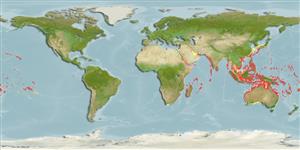Teleostei (teleosts) >
Anguilliformes (Eels and morays) >
Muraenidae (Moray eels) > Muraeninae
Etymology: Gymnothorax: Greek, gymnos = naked + Greek, thorax, -akos = breast (Ref. 45335).
More on author: Shaw.
Environment: milieu / climate zone / depth range / distribution range
Ecology
Marine; freshwater; brackish; reef-associated; depth range 1 - 51 m (Ref. 58302). Tropical; 38°N - 36°S, 18°E - 129°W
Indo-Pacific: East Africa (Ref. 33390) to Marquesas and Mangaréva, north to the Ryukyu and Hawaiian islands, south to Lord Howe Island. Southeast Atlantic: South Africa.
Size / Weight / Age
Maturity: Lm ? range ? - ? cm
Max length : 120 cm TL male/unsexed; (Ref. 1602); common length : 80.0 cm TL male/unsexed; (Ref. 30573)
Occurs in coral-rich areas of lagoon and seaward reefs from depths of 1 m to at least 36 m. Prefers very shallow depth and juveniles often in intertidal zones (Ref. 30404). Benthic (Ref. 58302). Often seen hunting during low tide among partly exposed reefs (Ref. 48635). Feeds mainly on fishes, also on crustaceans, by day and probably also at night (Ref. 13550). Caught with various nets (Ref. 30573).
Life cycle and mating behavior
Maturity | Reproduction | Spawning | Eggs | Fecundity | Larvae
Chen, H.-M., K.-T. Shao and C.T. Chen, 1994. A review of the muraenid eels (Family Muraenidae) from Taiwan with descriptions of twelve new records. Zool. Stud. 33(1):44-64. (Ref. 6934)
IUCN Red List Status (Ref. 130435)
Threat to humans
Reports of ciguatera poisoning (Ref. 4690)
Human uses
Fisheries: minor commercial; aquarium: commercial
More information
Common namesSynonymsMetabolismPredatorsEcotoxicologyReproductionMaturitySpawningSpawning aggregationFecundityEggsEgg development
ReferencesAquacultureAquaculture profileStrainsGeneticsElectrophoresesHeritabilityDiseasesProcessingNutrientsMass conversion
Tools
Warning: mysqli::__construct(): (HY000/1040): Too many connections in /var/www/html/includes/speciessummary.lib.php on line 2414
Can't connect to MySQL database fbquizv2. Errorcode: Too many connections
